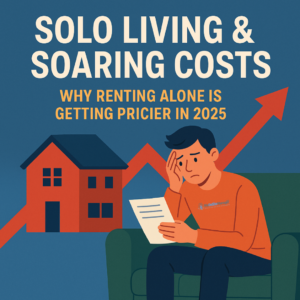Living alone has long been associated with freedom, privacy, and personal space—but in 2025, it comes with a steep price tag. According to Zillow’s latest data, renters who choose to live solo are paying thousands more per year than those who share a home. The rising cost of independence is reshaping how people view solo renting and adding pressure to an already strained rental market.
How Much More Are Solo Renters Paying?
The numbers speak volumes:
-
In March 2025, the median rent for a one-bedroom unit hit $1,504, marking a 4.4% increase from last year.
-
Renters living alone now pay, on average, $7,000 more per year compared to those splitting a two-bedroom unit.
-
Just four years ago, in 2021, this gap was $5,800. It jumped to $7,000 in 2024, and it’s still climbing.
This widening cost gap shows how quickly expenses have ballooned for individuals seeking their own space. While inflation and housing shortages continue to drive up prices, solo renters are uniquely vulnerable since they shoulder the full rent burden.
Where Is It Most Expensive to Live Alone?
Some cities stand out for their massive “solo rent premium”—the extra cost of renting alone compared to splitting a place:
| City | Annual Solo Rent Premium |
|---|---|
| San Jose, CA | $21,000+ |
| New York, NY | $19,000+ |
| San Francisco, CA | $17,000+ |
| Boston, MA | $15,000+ |
| Washington, DC | $14,000+ |
In tech hubs and urban cores like these, high rents and limited inventory make solo living feel more like a luxury than a necessity.
In contrast, cities like Cleveland, Pittsburgh, and Detroit offer far lower solo premiums—making them increasingly attractive to young professionals or remote workers seeking independence without the financial squeeze.
Why Is This Happening?
Several factors are contributing to this trend:
-
Post-Pandemic Shifts: Remote work has allowed more people to prioritize space and privacy, leading to increased demand for solo rentals.
-
Low Housing Supply: The lack of affordable, single-bedroom units puts upward pressure on prices.
-
Delayed Homeownership: Many millennials and Gen Z renters are postponing buying a home due to high mortgage rates and down payment requirements, keeping them in the rental pool longer.
-
Inflation: Rising costs for utilities, services, and property maintenance are passed on to renters, hitting solo renters the hardest.
The Impact on Renters
For many Americans, this means tough choices:
-
Sharing space again—even if it compromises privacy or comfort.
-
Relocating to more affordable areas or suburbs.
-
Delaying milestones like moving out, starting a family, or buying a home.
Renting alone is no longer just about lifestyle preference—it’s about economic feasibility.
What Can Be Done?
While personal decisions matter, broader policy and housing reform are needed to ease the pressure. Cities and developers must prioritize building more affordable, smaller units, and local governments should incentivize diverse housing stock.
In the meantime, renters can:
-
Compare rent-per-bedroom ratios to understand their local market.
-
Negotiate lease terms or explore roommate agreements for flexibility.
-
Use rental assistance programs or cost-sharing apps to manage expenses.
Final Thoughts
Renting solo used to be a rite of passage—your first apartment, your personal space, your peace. But in 2025, it’s becoming increasingly out of reach for many. As demand continues to outpace supply, solo renters must navigate a challenging market with strategic choices and financial resilience.
Whether you’re a renter, a landlord, or a housing advocate, understanding these shifts is essential. The future of renting may be less about how much space you want—and more about how much you can afford.
Source:
Investopedia – Renting Your Own Place Is Getting More Expensive

